14 Handy Tricks To Get Better Sleep While Backpacking
Backpacking is hard work, but it’s also supposed to be fun (even if it’s of the Type II variety). When you’re deep in the mountains with dozens of miles between you and the nearest town, the last thing you need is a bad night’s sleep. Proper rest is crucial to your strength and spirit.
It took me forever to get comfortable sleeping outside. Partly it was the rocks and roots under my back, and partly it was the sheer weirdness of sleeping outside the protective embrace of walls and roof for the first time. But I got over it in the end, and now I can rest as easily on the trail as I would in my own bed. In fact, since getting into backpacking and thru-hiking, I now sleep better on and off the trail than I ever have in my life.
In this article, I’ll outline the habits and tricks I use to overcome anxiety, aches, and adverse conditions for a peaceful night of sleep. This advice is backcountry-specific, but many of these suggestions are transferable to off-trail life as well.
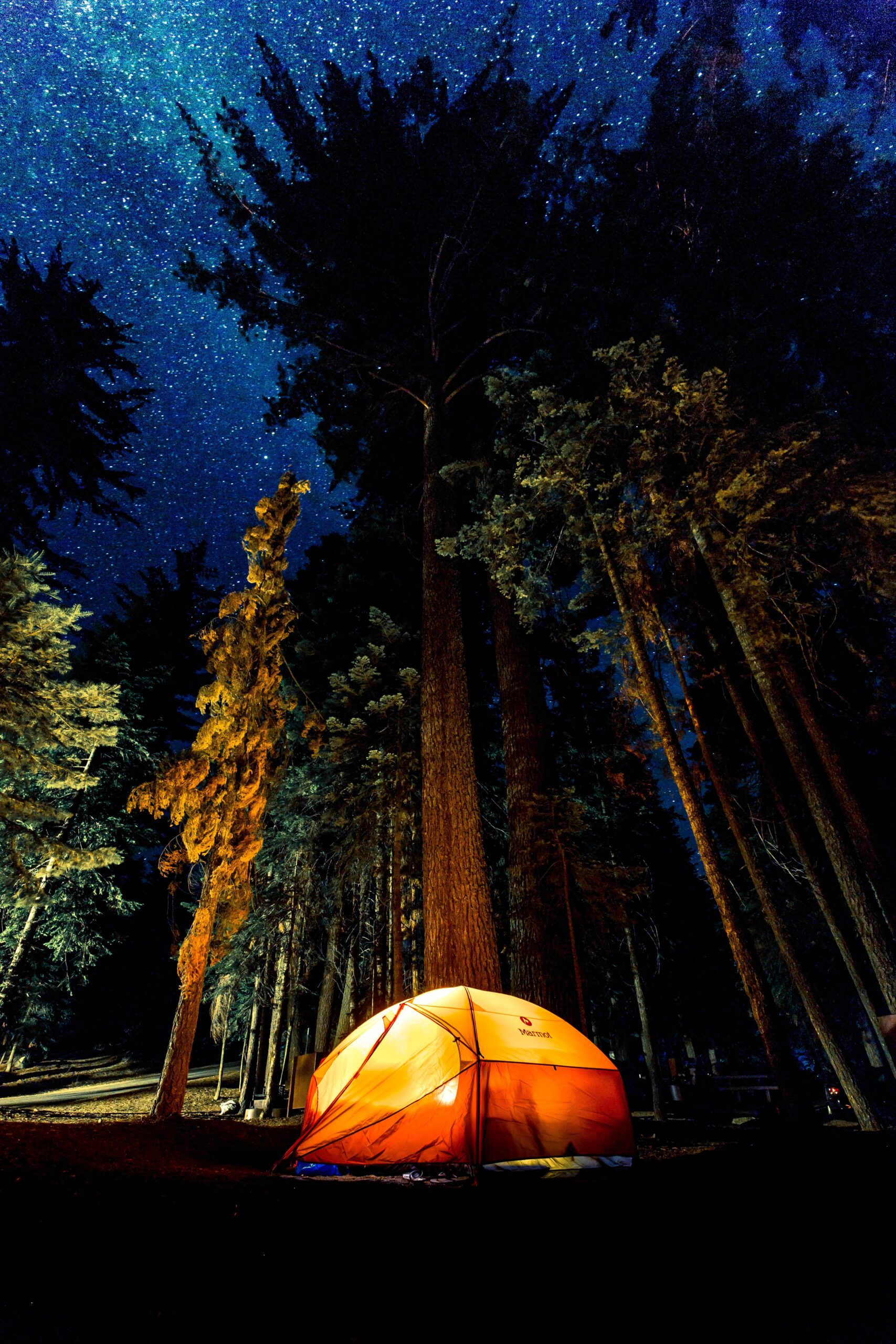
Photo: Denys Nevozhai.
Give Yourself Time
First of all, feeling out of sorts the first few times you sleep outside is completely normal. If you’ve never done it before, it will take time to adjust. And even seasoned hikers get into a funk every now and then.
On trail, as in regular life, insomnia is often largely a mental game. Self-reproach isn’t a very restful emotion, so rather than beating yourself up about not sleeping enough, accept that the occasional rough night is an inevitable feature of trail life. By anticipating the likelihood of difficult sleep, you can plan ahead and take steps to mitigate it.
How To Get Better Sleep in the Backcountry
1. Examine Your Fears
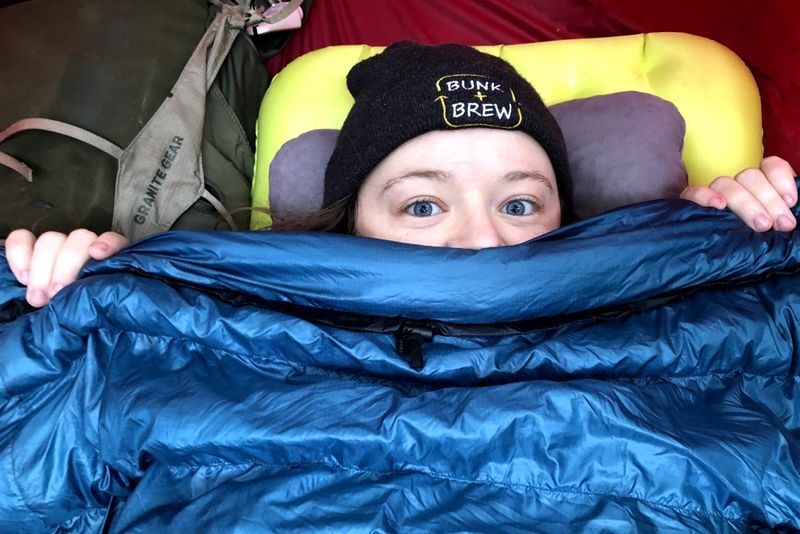
Photo: Samantha Olthof
Sleeping outside can be unnerving. Most of us were fortunate enough to grow up with a roof over our heads at night and a locked door between us and the world. When you swap those sheltering walls for the dubious protection of a flimsy silnylon tent, you might suddenly become aware of how puny and vulnerable you really are.
Take some time to unpack the anxieties that keep you up at night—by understanding them, you can start to dispel them.
Are you afraid of bears? Remind yourself that black bears generally aren’t aggressive and would much rather pilfer your snacks than harm you. Is it the threat posed by other humans that keeps you up at night? People can be dangerous, true, but crime rates are statistically much lower on trails than in cities.
Another common backcountry fear is simply of the wild itself—of getting lost or hurt or generally just not being prepared for everything nature can throw at you. This is one of those trepidations that gets better with time and familiarity with the outdoors. So again, go back to square one: give yourself time.
2. Keep Trekking Poles, Headlamp, and GPS Device On-Hand
A little preparedness goes a long way.
The chances of you running afoul of a two- or four-legged creature while in your tent are slim, but it’s still a legit fear. Arm yourself with your long poky sticks for whatever they’re worth, and keep your GPS device (inReach, Spot, etc.) handy in case you need to call for help. Feeling like you’re prepared to deal with hairy situations can go a long way toward easing your anxiety.
And make sure you have spare batteries for your headlamp. A little light is very reassuring on a dark night, and you’ll feel even better knowing you don’t have to worry about your battery running out and plunging you into literal and, potentially, metaphorical darkness.
3. Pee Bottle
Getting out of bed to pee is fairly uncomfortable on a backpacking trip, especially if it’s cold or rainy. The struggle of extracting yourself from your cozy bag and going out into the elements is enough to wake anyone up, and if you’re already worried about what might be lying in wait out there for you, it’s even worse.
Save yourself the struggle and get a pee bottle so you don’t have to leave the comfort of your tent. It might sound gross now, but everyone does it. And once you’ve experienced the magic for yourself, you’ll never look back. Pro-tip: a splash of strong peppermint soap will keep the bottle smelling fresh day after day.
4. Distract Yourself
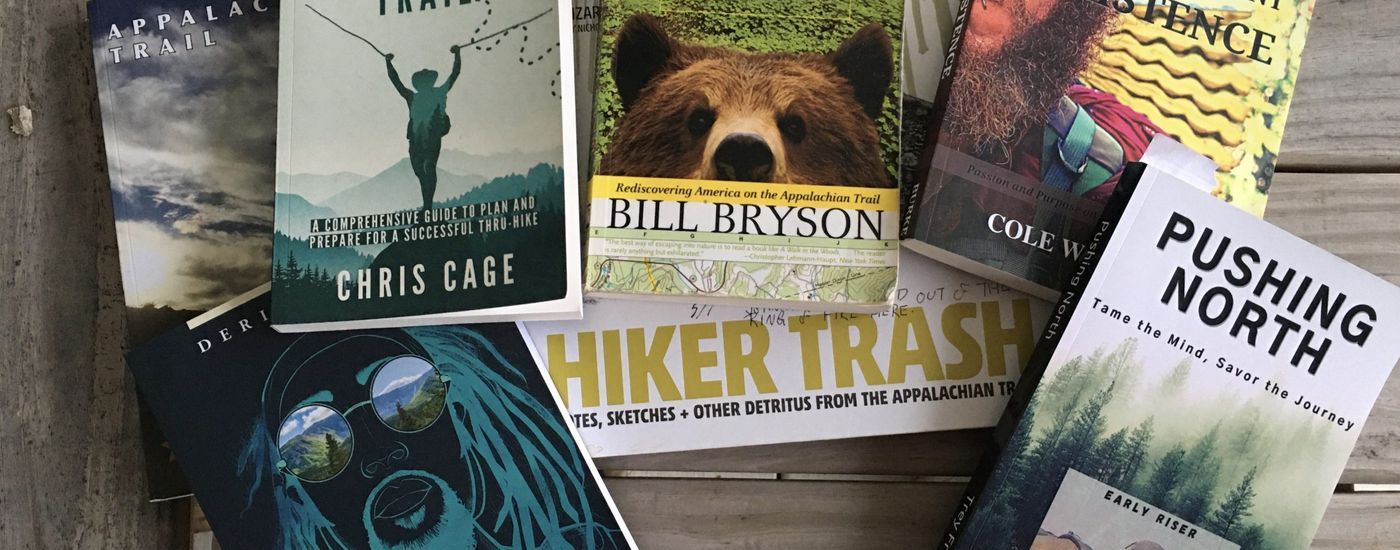
Photo: Carol Fielding
If anxiety is keeping you awake, don’t just lay there listening to ominous rustling sounds outside your tent and picturing your impending doom. A good book or enthralling podcast is a great way to take your mind off things. Even if distracting yourself with media keeps you awake for the immediate future, it will help you get over your nerves for better sleep in the long run.
Even in the civilized world, the conventional wisdom for insomniacs is to get up and do something rather than remain in bed stewing over your sleeplessness. If books and music don’t do it for you, do a little stretching or spend some time patching that snag in your base layer that you’ve been putting off fixing. When you start to feel drowsy, put your project aside and try again to sleep.
5. Wear Earplugs
What does the fox say? From my tent, its peculiar cry sounds a lot like, “I’m a psycho sneeze monster, and I’m coming to dismember you in your tent while giggling insanely. HEE! HEE!”
In the dark forest, an adorable chipmunk scampering through the leaves sounds like a charging bear. An actual bear sounds like a truck crashing through the undergrowth. And those goddamn foxes, of course, sound like 15–45 minutes of anxiety and lost sleep as I game out various Kelly-vs.-Slylock Ultimate Showdown scenarios in my mind’s eye. (I don’t love my odds, but at least I’ve got those trekking poles, eh?)
So anyway, while I’m generally a big advocate for situational awareness, sometimes you just have to cut out the eerie night sounds to get your snooze on. Earplugs do the job, or you can play soft yoga music through headphones (but this uses a lot of battery).
Earplugs also come in handy for cutting out 0ther unwanted noise, like a snoring sheltermate or a chorus of spring peepers (if you know, you know). I never leave home without a pair tucked into my first aid kit.
6. Upgrade Your Sleep System
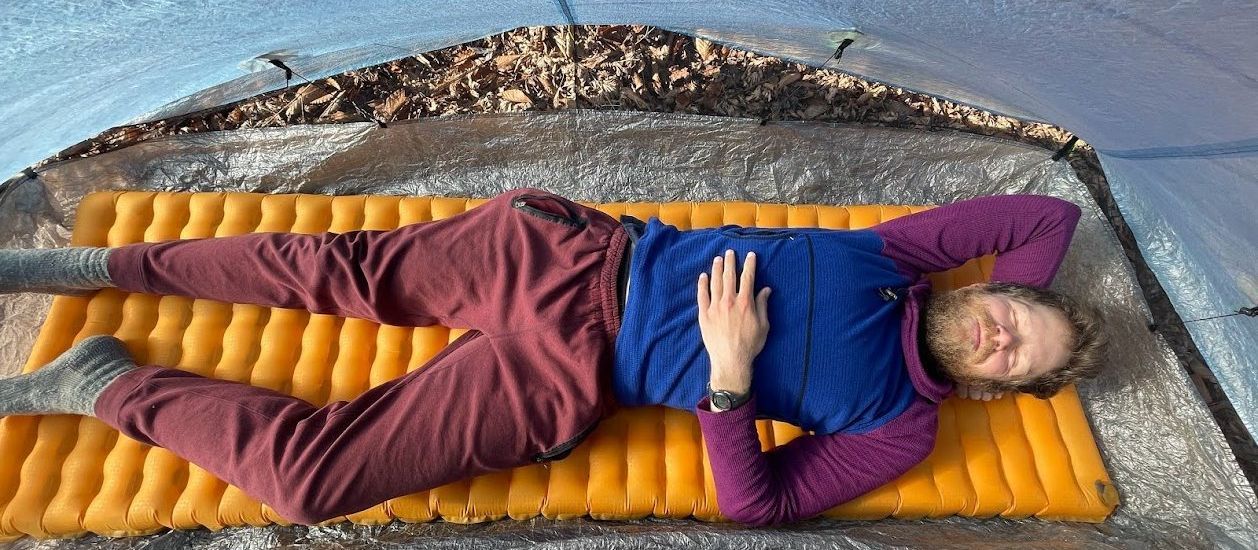
Photo: Carl Stanfield
Sometimes the z’s won’t come because you’re too cold and drafty to get comfortable. Pay attention to your sleeping bag temperature rating in particular: many bags, especially men’s and unisex bags, are rated to the temperature at which an average warm sleeper can maintain thermal equilibrium while curled up to conserve warmth—which isn’t the same thing as sleeping comfy and cozy.
Try investing in a bag with a more conservative temperature rating and/or a sleeping pad with a higher R-value. Closed-cell foam pads typically only have an R-value of 2, while inflatable pads can have R-values as high as 7. The Therm-a-Rest NeoAir XTherm NXT is the warmest pad on the market with an R-value of 7.3.
If you don’t want to shell out for a complete sleep system overhaul, you can modify your existing setup by adding a sleeping bag liner and/or a 1/8-inch supplemental foam pad.
READ NEXT –
7. More Tricks To Sleep Warmer
Beyond just upgrading your gear, you can employ the following tricks to boost your warmth overnight:
- Make a hot water bottle to warm your sleeping bag by adding hot (not boiling) water to a Nalgene bottle.
- Eat a fatty meal before bed.
- Do sit-ups or jumping jacks just before getting into bed—enough to get your blood pumping but not enough to make you sweat.
- Layer up: that thing about sleeping naked keeping you warmer is a myth. Unless you’re wearing tight clothes that constrict your circulation or so many bulky layers that you compress the insulation of your sleeping bag (unlikely), putting on more clothes, up to and including your rain jacket, will help you sleep warmer.
8. Tricks To Sleep Cooler
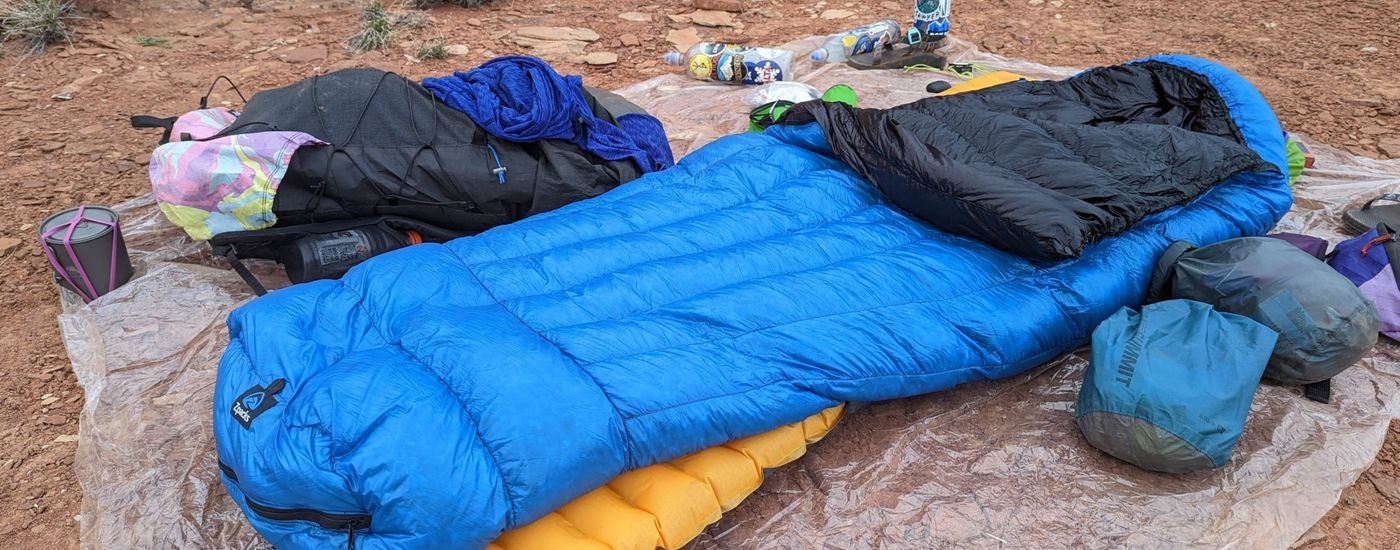
Photo: Kate Richard
On the opposite end of the spectrum, many people get poor sleep because they overheat at night. This can be tricky to deal with, especially if you suffer from hot flashes or full-on night sweats, to which there’s no easy or perfect solution. But the following tricks can help you to mitigate the I’m-too-hot issue.
- Use a quilt instead of a sleeping bag. It’s easier to fold down or stick arms or legs out to dump heat. If you have a full sleeping bag, go for a model with a two-way zipper so you can open up the footbox and stick your feet out.
- Wear thinner/less clothing. Silk base layers are popular.
- Sleep with cold water bottles. Make sure they’re tightly sealed! They’ll suck the heat right out of you, and as a bonus, you’ll get warm water to drink in the morning.
- Unzip your bug mesh. Your tent mesh traps a surprising amount of heat, so unzipping it will help you sleep cooler. If you can go without your rainfly, that’s even better. The coolest solution of all, of course, would be to cowboy camp when conditions allow.
9. Medications and Supplements
Some hikers carry sleep supplements like melatonin or valerian root to help conk them out—just make sure to repackage them into a ziplock bag to save pack space. Also, our intrepid leader, Zach, says he’s had good results with magnesium l-threonate supplements.
Meanwhile, if aches and pains are keeping you up at night, don’t underestimate the power of good old Tylenol PM to knock you out. This obviously isn’t a long-term sleep solution, but when your body is killing you and you really need a full complement of z’s, it’s good to have a few Tylenol PMs on hand.
10. Stretch Before Bed

Photo: Madison Dragna
Stretching before bedtime is a useful nightly routine for footsore long-distance hikers. Besides keeping your muscles happy so you can avoid injury, stretching is a great way to improve your night’s sleep.
You can ease your discomfort by stretching out tense muscles and doing a little self-massage before hitting the sack. The physical tension release is invaluable. It’s also sort of meditative, a gentle transition phase during which you can downshift into snooze mode.
READ NEXT – Yoga for Hikers and Backpackers
11. Upgrade Your Sleeping Pad (And Experiment With Inflation)
If you’re using a foam sleeping pad and struggling to get good sleep on trail, table every other piece of advice on this list and go try an inflatable sleeping pad first. Closed-cell foam pads have many virtues, but comfort isn’t one of them. Some hikers can make it work; others can’t. Inflatable pads offer more cushioning and keep you from feeling every rock and root under your tent.
One of the greatest things about inflatable sleeping pads is that you can control the level of firmness. I struggled for months with a sore lower back in my tent before I realized I was overinflating my sleeping pad. Try adjusting the inflation level to see if a firmer or softer mattress works better for you.
12. Get a More Comfortable Pillow
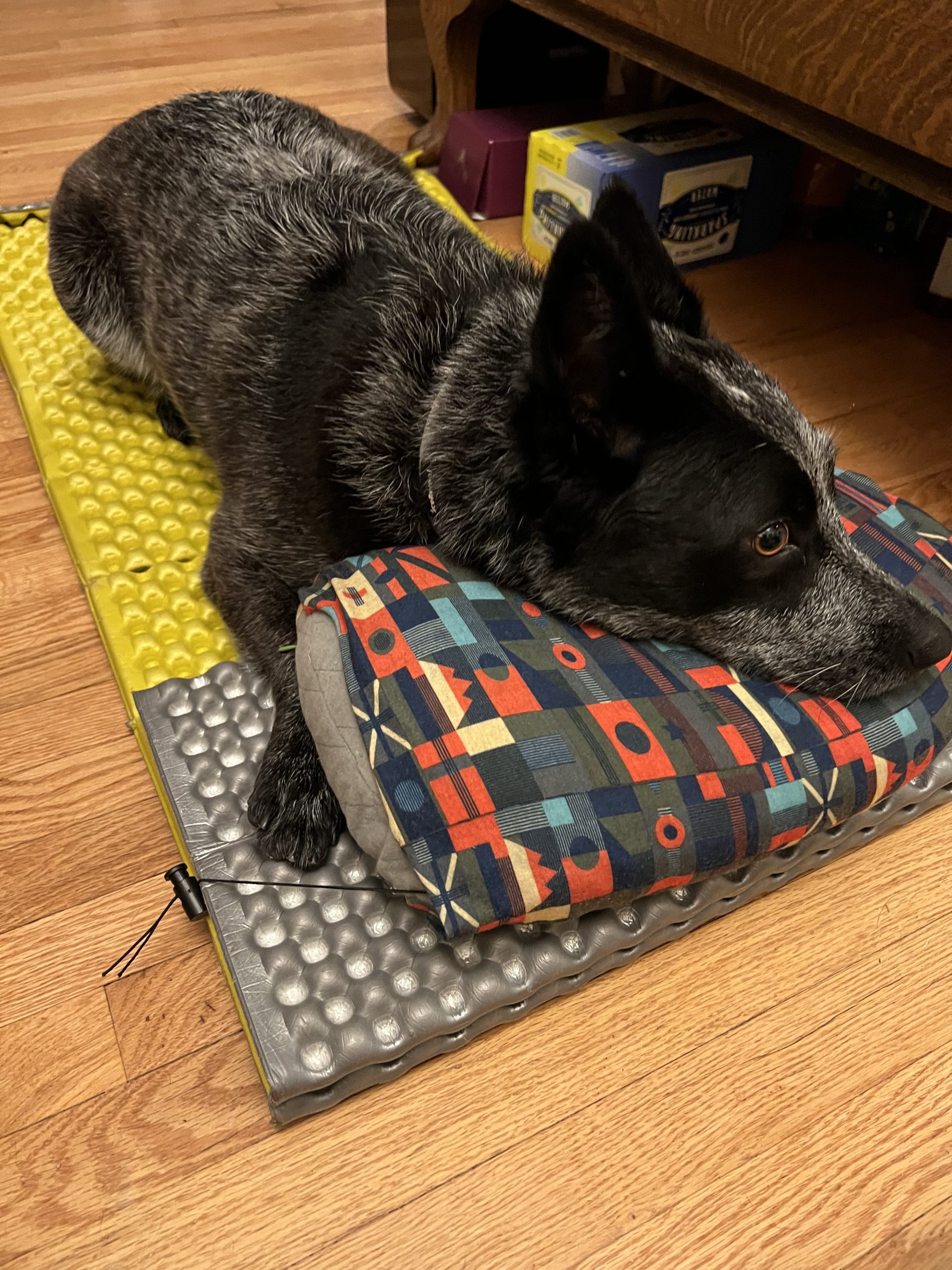
Photo: Kristina Larson. Also, look at this dog!
I’m a fan of the good old clothes-in-stuff-sack technique myself, but many thru-hikers swear by a proper pillow in the backcountry. The Sea to Summit Aeros inflatable pillow and its ilk are among the most popular luxury items in thru-hikers’ backpacks. It’s a small investment of money and weight that can pay huge dividends in terms of your nightly comfort—so why not?
On that note, don’t be afraid to experiment with your pillow configuration. I actually find my improvised stuff-sack pillow more comfortable than the inflatable type because I can control the size and shape. Get creative and consider all of your vaguely soft gear as a possible pillow candidate: when not in use, my rain fly in its little stuff sack is also a killer pillow, as is the removable brain on one of my larger packs with my puffy stuffed inside it.
13. Try a Hammock
Some hikers find hammocks easier on their backs: suspended above the ground, hard earth and rocks and roots are a non-issue. You’ll have to work a bit harder to stay warm and find a viable sleeping position, but there’s a reason the hammock lifestyle has such a passionate following.
One caveat: hammocks really are not the best choice if you’re a side sleeper, and they’re a hard pass if you like to sleep on your stomach.
READ NEXT – Hammock vs. Tent for an Appalachian Trail Thru-Hike
14. Hike More Miles
Hiking takes a lot of energy! I think the biggest reason I now sleep so soundly in my tent is that I’m so dadburn tired by the end of each day. Many thru-hikers find that sheer physical exhaustion is the best treatment for backcountry insomnia; if you’re having a hard time sleeping and nothing else is working, maybe you need to push a little harder each day to ensure you’re primed for sleep.
Common sense and body awareness are obviously key to this strategy. You want to strike a balance between wearing yourself out and not injuring/emaciating yourself (and hiking the hike that YOU want, which might include shorter days). So yeah, make your own call here, but just know that the physical demands of a 20-plus-mile day often trump sore muscles and anxious thoughts on a thru-hike.
Conclusion

Photo: Katie Kommer
Long-distance hiking is exhausting. The sheer fatigue of trekking long miles through the mountains each day is often enough to overcome your worries and physical discomforts, bringing sleep in an instant. But it doesn’t always work that way. When sleep is slow to come, try these techniques to get your Circadian rhythm back on track.
But above all, be patient with yourself. Bad nights of sleep can and do happen, even on trail, and stressing about it isn’t going to make it better. Get as much rest as you can overnight and follow the golden rule during daylight hours (Never Resist a Nap).
Featured image: Graphic design by Zack Goldmann.
This website contains affiliate links, which means The Trek may receive a percentage of any product or service you purchase using the links in the articles or advertisements. The buyer pays the same price as they would otherwise, and your purchase helps to support The Trek's ongoing goal to serve you quality backpacking advice and information. Thanks for your support!
To learn more, please visit the About This Site page.


Comments 7
Surprised that the effects from two popular chemical agents are not mentioned:
1 – alcohol helps you fall asleep, but generally does not lead to a full night of restful sleep, especially in the wee hours.
2 – in weed-legal states, there is a plethora of thc-infused products that are miraculous sleep aids, with no hangover effect. magic!
As a lifelong side sleeper, I’ve found that it is much easier to sleep in hammock than on the hard and lumpy ground. You can get a reasonably flat lay in a “gatheered-end” hammock by lying diagonally to the ridgeline, and can get a somewhat side orientation if desired. But there are also “bridge”-style hammocks which allow for an even flatter lay. Some report they can even stomach sleep in them. Bridge hammocks have crossbars at each end, creating a closed-ended taco-like shape, or bathtub if you will, as opposed to the banana-like hang of a gathered end hammock. Those crossbars add a bit of extra weight, and since they are comfort-focused, don’t tend to get as much ultralight design improvements as the gathered-end models from manufacturers, but there could be some lighter models out there I’m unaware of.
As to warmth, that is an outdated myth. In the early days, people would take a traditional sleeping bag into their hammock and get a cold butt and back when the down got compressed against the fabric, removing its loft there and thus negating its insulating capability in those spots. Modern hammock hangers typically use an underquilt that hangs under the hammock, snug to the hammock but free to remain fully lofted. A top quilt inside completes the bedding. This can be a very warm setup. Conversely, on a hot night, the underquilt can be shifted or dispensed with for the coolest possible way to sleep.
Hammock, underquilt, top quilt, and tarp can compare very favorably weight-wise with tent, sleeping bag, and sleeping pad, and can even be lighter if lightweight or ultralight options are chosen. My current hammock set up, including 20°F quilts with 20% overstuff, comes at 2lbs 12oz for everything. This is vs 3 lbs 10oz to over 5 lbs for ultralight combos of tent, quilt and sleeping pad (data from Halfway Anywhere’s 2022 PCT thruhiker gear survey’s lists of favorites for each category). Different combos of gear will weigh more or less, but my point here is that weight isn’t a factor either way, it’s about the comfort. On the plus side, you can also sit in your hammock sideways as a very comfy camp chair, and can save over a pound of weight by leaving your Helinox at home.
The learning curve for me was less about learning to adapt as a side-sleeper, and more about not having a clean enclosed room to change clothes and manage gear. Learning to change clothes lying down when the skeeters are out, etc. Also learning how to tie the tarp out in “porch mode” with trekking poles for extra room for cooking, or hanging out. A scrap of tyvek can help create a clean spot to stand or put things if needed, but isn’t necessary once you get the hang of keeping things off the ground. On the plus side, an unanticipated benefit for me was feeling more connected to the outdoors than in an enclosed tent, since the separate tarp and bugnet-topped hammock can make it easy to see out, depending on how you rig your tarp. This is nice as you get the best of both cowboy camping and the protection of an enclosed shelter. You can view a nice sunrise or sunset while snug in your quilts. It also can lessen anxiety of hearing a noise at night when you can easily see around you by lifting your head and looking around through the bugnet and under the lower edges of the tarp.
Puzzled why you would recommend strongly scented peppermint soap to put in an item to keep in your tent at night (bears)?
Great tips. Nice work.
My feet usually get cold while sleeping, even with socks, so I put a jacket over the bottom end of the bag. Zip up the jacket and slide it up over the bag. In summer, I’ll do this with a rain jacket but in winter I’ll use a puffy. This makes a lot of difference.
Only in the hiking community would you find advice on how to keep your piss bottle clean and fresh-smelling.